#bactec
Explore tagged Tumblr posts
Text
Lab Tour
hi y'all, I said I would do this, so here's a short walkthrough of the instruments in the lab I work in ^_^
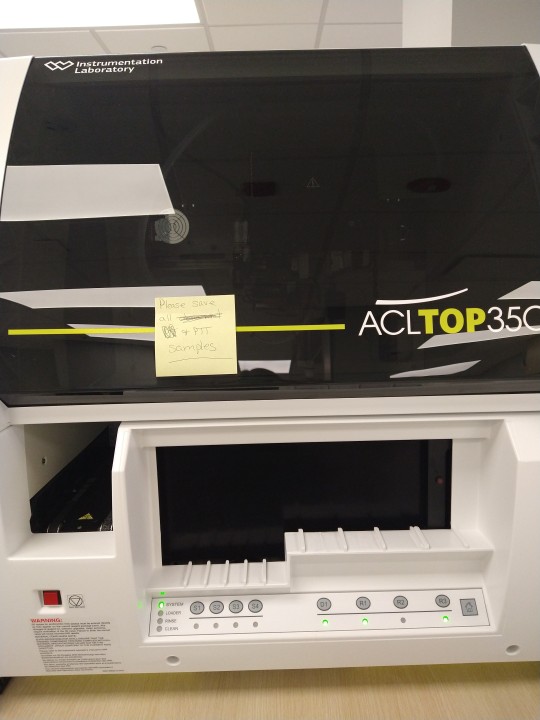
This is our coagulation study machine! It runs tests for PT, PTT, and D-dimer. (One of my coworkers is doing a QC study which is why you see that note on there.)
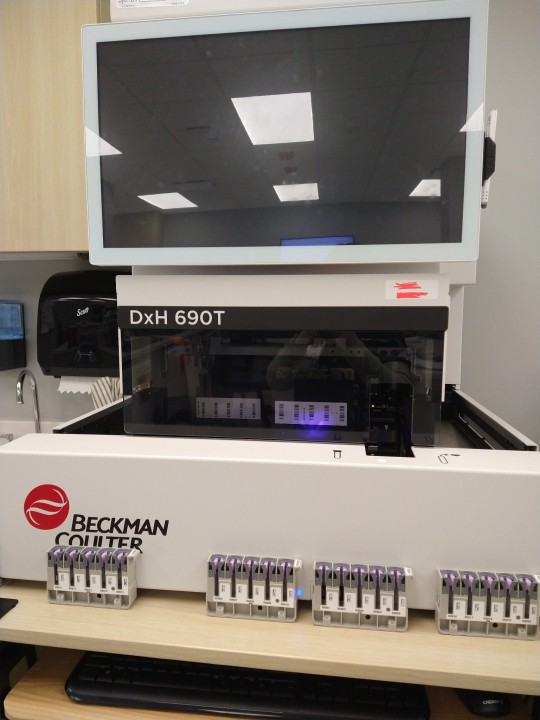
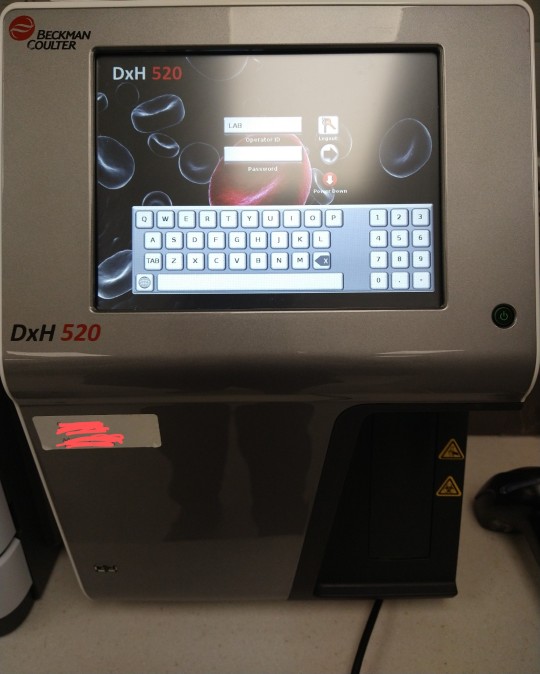
These are the hematology analyzers! The 690 runs with cassettes (you can see them in front) and so you can put multiple samples on the machine and walk away. The 520 is our smaller back-up machine. It's very cute :) but when the 690 is down it's a pain bc the 520 can only run 1 sample at a time.
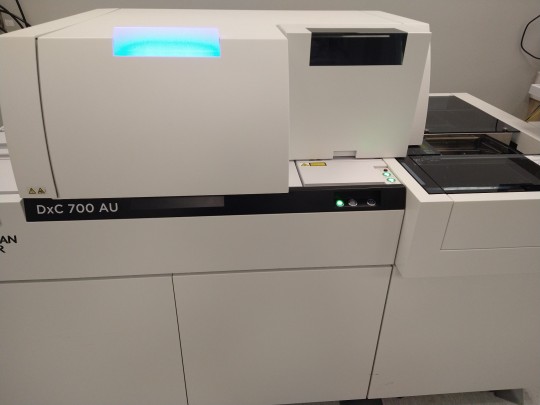
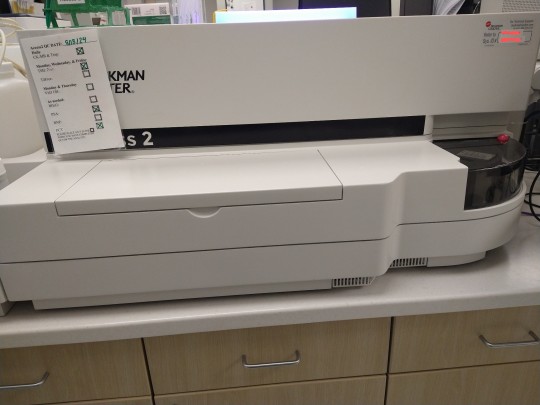
These are our chemistry analyzers. The AU is what we call the "big" analyzer. It does all the metabolic panels, toxicology, and A1Cs. The Access is the "little" analyzer. It takes care of cardiac biomarkers, thyroid hormones, and other assorted tests not covered by the AU.
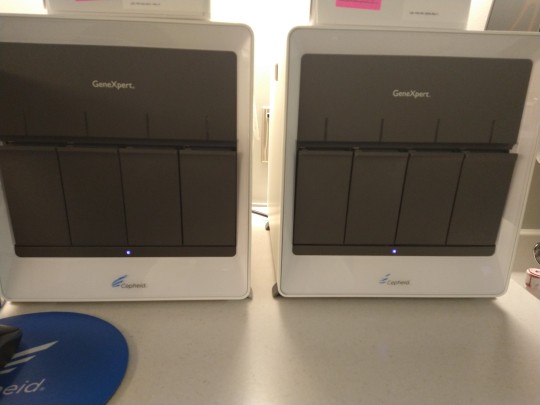
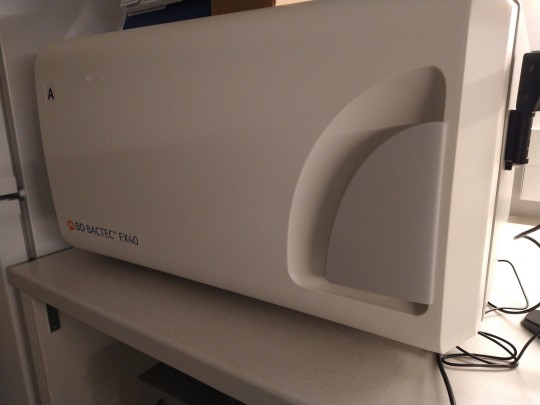
Here are the micro machines! On the left is the Cepheid. It's a PCR machine. We run a variety of tests on it, like the "Fourplex" (RSV, COVID, Influenza A and B), Strep A, Strep B, Chlamydia/Gonorrhea, etc. And on the right is our Bactec, for blood cultures.
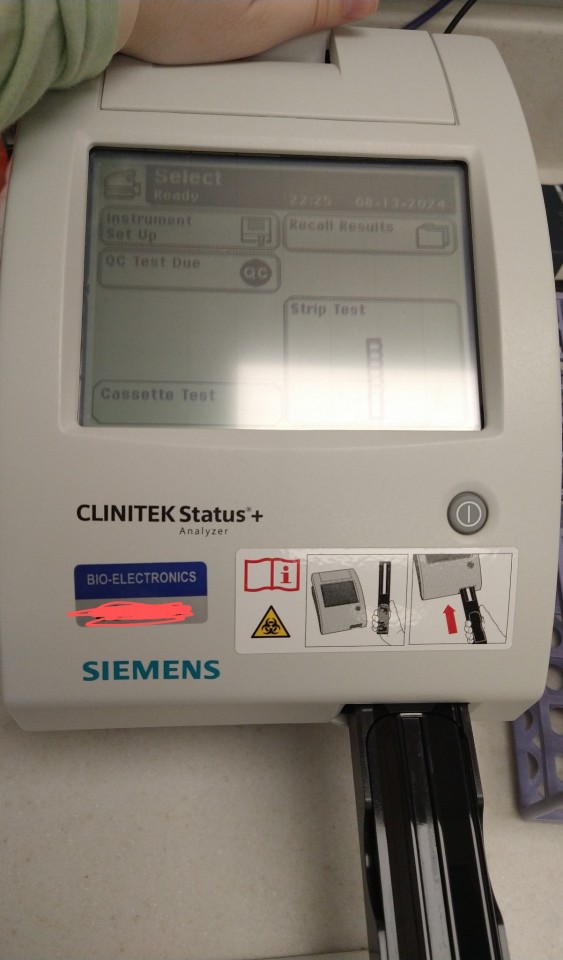
This is the Clinitek! It's a urine strip reader. Basically, we take urine, we dip a test strip in it, blot the strip, and put it on the machine. Depending on the results, we then look at the urine under a microscope. For example, if nitrates and leukocytes (WBCs) are present, we would look at the urine microscopically. There, if we saw bacteria, we could basically confirm a UTI.
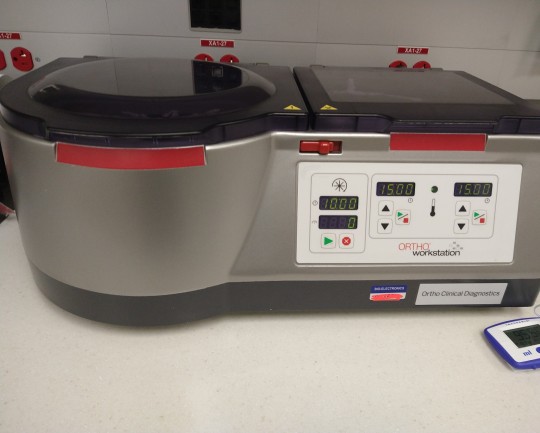
Finally, this is the Blood Bank centrifuge/incubator. We use gel cards for all our blood banking. The incubator is for IgG antibody screens. Our blood banking is done manually (some bigger hospitals have machines to do it, which is cool, but I do enjoy the manual method).
Aaaand yeah! That's basically it! I did leave out the centrifuges (2 for blood and 1 for urine) but those aren't that exciting lol. Thanks for coming with meeeee :)
8 notes
·
View notes
Text
Imma fucking murder to BacTec. Fuck that machine.
9 notes
·
View notes
Video
tumblr
Merry stat holiday pay!!!!
#healthcareworkerproblems thelabpotato#adventuresoflabpotato#inthelaboratory#laboratory#bactec#healthcareworkerproblems#healtcareworkers
0 notes
Photo


I also know how I am when I’m not drunk.
#HIS FACE!!! LKASDÖKJASÖDKLJFAÖLKDSJFLKDSJFHKASJDF#manner of death#manner of death spoilers#mod ep5#NO novel spoilers plz thx#can he just like not????!!!!!#ugh#now i have go back to work#lol have five missed calls#if it's about the bactec again i will cry
279 notes
·
View notes
Link
The BD BACTEC™ Automated Blood Culture System utilizes fluorescent technology in detecting the growth of or- ganisms in the blood culture bottles. When microorganisms are present in the cultured vials, they metabolize nutrients in the culture medium, releasing carbon dioxide into the medi- um.
0 notes
Text
Sepsis Diagnostics Market Growth Drivers & Opportunities | MarketsandMarkets
The demand for sepsis diagnostic products is expected to grow mainly due to factors such as the increasing public-private funding for sepsis diagnostic research activities, the growing burden of infectious diseases, the rising number of sepsis incidences, and growing government initiatives for creating sepsis awareness.
Sepsis is a very difficult condition to diagnose and the risk of mortality increases by 7.6% with a delay of even 1 minute in antibiotic administration in septic shock patients with hypertension. Thus, increasing the need for the rapid diagnosis of sepsis to reduce the delay of antibiotic therapy among patients with sepsis. Many sepsis diagnostic manufacturers are expanding their product offering in point of care technology rapidly detecting the sepsis, reducing the overall turnaround time of diagnosis.
The BACTEC Plus, BacT/Alert, and BACTEC FX blood culturing instruments manufactured by BD Company (US) is an automated microbial detection system offering a rapid diagnosis of sepsis in the turnaround time of three hours.
According to the new market research report "Sepsis Diagnostics Market by Technology (Microbiology, PCR, Sequencing, Biomarkers), Product (Reagents, Assay, Instruments, Software), Test Type (Lab, POC), Pathogen (Bacterial, Viral, Fungal), End User (Hospital, Pathology Lab) - Global Forecast to 2026", published by MarketsandMarkets™, the global market is expected to reach USD 771 million by 2026 from USD 503 million in 2021, at a CAGR of 8.9% from 2021 to 2026.
Browse in-depth TOC on "Sepsis Diagnostics Market" 201 – Tables 47 – Figures 236 – Pages
Download PDF Brochure: https://www.marketsandmarkets.com/pdfdownloadNew.asp?id=92673155
The demand for sepsis diagnostic products is expected to grow mainly due to factors such as the rising prevalence of sepsis across the globe. Factors such as the increasing geriatric population, a growing number of surgical procedures, a high incidence of hospital-acquired infections, and the commercialization and availability of a wide variety of approved sepsis diagnostic devices are expected to drive market growth.
The COVID-19 pandemic had a positive effect on the sales of diagnostics products for sepsis. The global spread of covid-19 and the emerging cases of sepsis among covid-19 patients are likely to increase the demand for rapid diagnosis, accelerating the utilization of instruments, reagents, assay kits for detection of sepsis. Lockdowns resulting from the pandemic caused people to delay undergoing health checkups, affecting the number of tests performed and reagent sales.
The shortage of skilled professionals is a major concern worldwide; only 50% of patients with severe sepsis transported by the EMS system have a paramedic. The lack of trained paramedics affects each phase of patient caremdash;sepsis awareness, screening patients for the presence of sepsis, and making an appropriate.
The current COVID-19 pandemic has highlighted the risk faced by older adults, who are more susceptible to complications, including acute respiratory distress syndrome, usually due to pneumonia, which increases the risk of developing sepsis. Thus, increasing the need for early diagnosis of sepsis among patients with covid-19 infections.
Request Sample Pages: https://www.marketsandmarkets.com/requestsampleNew.asp?id=92673155
Based on technology, the biomarkers segment is expected to register the highest growth rate during the forecast period
Based on technology, the global sepsis diagnostics market is segmented into microbiology, molecular diagnostics, immunoassay, flow cytometry, microfluidics, and biomarkers. The biomarkers segment is expected to grow at the highest CAGR during the forecast period. The growth of this segment can be attributed to various advantages offered by this technique in the diagnosis of sepsis and the growing need for early disease diagnosis.
North America accounted for the largest share of the sepsis diagnostics market
Geographically, the sepsis diagnostic market is segmented into North America, Europe, Asia Pacific, and the Rest of the World. North America is estimated to account for the largest share of the market. This can be attributed to the growing prevalence of sepsis, increasing incidence of hospital-acquired infections, fast adoption of high-end sepsis diagnostics devices, and rising government support for sepsis-related research.
0 notes
Video
Green Stock News All-Access Interview: Featuring Ross Orr, CEO of BacTec...
0 notes
Text
Impact of COVID-19 on Automated Cell Cultures in Healthcare Industry

COVID-19 Impact on Automated Cell Cultures in Healthcare Industry
The economy and businesses across the world have been influenced greatly because of the COVID-19 pandemic. The COVID-19 has spread globally in unprecedented ways due to its high infectious and contagious nature and lack of vaccine. The World Health Organization (WHO) declared COVID-19 as a pandemic due to its increased spread across the globe. According to the situation report of 7th June 2021 by WHO, 174 million corona cases had been reported globally and 3.7 million patients died due to the coronavirus. On a slightly positive note, a total of 157 million people have recovered, and 1.9 million vaccine doses have been administered.
Cell culture refers to removing cells from an animal or plant and their subsequent growth in a favorable artificial environment. Automated cell culture systems are instruments that mechanically carry out the steps involved in growing and maintaining a cell culture useful in any lab that works with cell biology, cell signaling, protein expression, or drug discovery. An automated cell culture system helps to grow cell cultures while saving labor time and reducing errors. Increasing demand for cell culture technology in vaccine production and wide acceptance of cell culture techniques in various applications accelerate the market growth. However, the high cost of automated cell culture systems and lack of skilled and certified professionals are expected to obstruct the market growth.
COVID-19 pandemic created problems for many drug, clinical, medical equipment, and device manufacturing companies, including market players that provided automated cell culture products & services. Though, different kind of policies has been adopted by different companies across the globe for carrying forward the manufacturing processes.
PRICE IMPACT
COVID-19 claimed a considerable number of lives worldwide, which is a concern in countries with high patient co-payments and an appreciable number of families going into poverty when members become ill. Consequently, there is a need to review prices and availability of pharmaceutical products during the COVID-19 pandemic to provide future direction.
The pandemic has impacted on utilization and prices of pertinent medicines and products but moderated by increased scrutiny. Key stakeholder groups can play a role in enhancing evidence-based approaches and reducing inappropriate purchasing in the future.
For instance;
• The Price of BACTEC FX-40 Automated Blood Culture System manufactured by BD is USD 10,608.08
• The price of Gibco HEPES, a reagent used in cell culture manufactured by Thermo Fisher Scientific, is USD 30.90
Product cost is the major setback for the market as it is expected to decrease the demand due to high costs. As the instruments and consumables related products such as cell counters, reagents, and buffers have high prices, the cost of automated cell cultures can impact the market.
IMPACT ON DEMAND
Today, most biotechnology products are primarily dependent on the mass culturing of cell lines. Cell cultures have found applications in diverse areas and serve as a model system for numerous research efforts. An increase in funding from the government for cell-based research is significantly triggering the growth of the market. In addition, cell culture techniques are widely used as an alternative to current egg-based strategies for developing cell-based vaccines. Thus, cell culture technology has been widely used in developing U.S. -licensed vaccines such as vaccines against rubella, smallpox, chickenpox, hepatitis, rotavirus, and polio.
For instance,
• Over the last month and a half, the Centre for Cellular and Molecular Biology has established stable cultures of COVID-19 causing coronavirus. The lab's ability to culture the virus enables CCMB to develop vaccines and test potential drugs to fight COVID-19.
As observed, because of the current COVID-19 situation, the demand for automated cell culture services gradually increased due to the wide acceptance of cell culture techniques in various applications and growth in the biotechnology sector. This shows that various initiatives taken by organizations and market players are helping to tackle this COVID-19 situation as products are made available, and the situation is likely to get better in the future.
IMPACT ON SUPPLY CHAIN
Lockdown policies in different countries have resulted in the closing of product providers, decreasing walk-in customers to prevent the spread of the disease. This led to a significant delay in the supply of the product. Also, during the lockdown period, the market for online delivery of products has seen a rise, which is normal considering the situation. The companies dealing in the automated cell culture worldwide have taken strategic steps to supply products to people across the world properly.
The Coronavirus Disease 2019 (COVID-19) pandemic triggered unprecedented increased demand for some clinical devices, as well as significant disruptions to global medical and clinical device manufacturing and supply chain operations. The FDA is monitoring the medical and clinical product supply chain and working closely with manufacturers and other stakeholders to evaluate the risk of disruptions and prevent or reduce their impact on patients, health care providers, and the public's health at large.
For instance,
· On March 27th 2020, the Coronavirus Aid, Relief, and Economic Security Act (CARES Act) was signed into law. The CARES Act added Section 506J to the Federal Food, Drug, and Cosmetic Act (FD&C Act). It provided the FDA—for the first time—with new authority intended to help prevent or mitigate negative public health impacts of medical device supply chain disruptions “during, or in advance of, a public health emergency declared by the Secretary under section 319 of the Public Health Service (PHS) Act.”
The FDA issued an immediately in effect guidance, Notifying CDRH of a Permanent Discontinuance or Interruption in Manufacturing of a Device Under Section 506J of the FD&C Act During the COVID-19 Public Health Emergency: Guidance for Industry and Food and Drug Administration Staff. This guidance is intended to assist manufacturers in providing the FDA timely, informative notifications about changes in the production of certain medical devices that will help the Agency prevent or mitigate shortages of such devices during the COVID-19 public health emergency.
· In April 2020, according to Indian Drug Manufacturers Association (IDMA), Vice-Chairman, T Sathish, the pharma sector in the country has been hit by a shortage of workforce, packaging materials, and transport the COVID-19 lockdown. This has led to a shortage of product packaging materials and has made matters worse for the pharmaceutical companies. He urged the government to permit the supporting industry to function to ensure that the supply chain was not disrupted.
This shows that even if the COVID-19 situation disrupts the supply chain of products, the initiatives taken by the government and different companies create hope for the proper supply and use of products available.
STRATEGIC DECISIONS FOR MANUFACTURERS
COVID-19 might have hampered the supply and use of products, but it also allows companies to improve their business by different means. As a pharmaceutical company always does, it tends to find newer and better ways to treat a disease; the same is true with automated cell culture services and products. Always bringing out better solutions in the market will increase their business efficiency.
For instance,
· In 2020, in the U.S., the companies with direct exposure to COVID-19 outbreak were taking several actions, including transporting available inventory to areas away from quarantine zones and near ports where it can be accessed for shipping, buying ahead to procure inventory and raw material that are in short supply in impacted areas, activating pre-approved raw material substitutions in places where the primary supplier is impacted. However, a secondary supplier is not updating customers about delays and adjusting customer allocations to optimize profits on near-term revenue or to meet contractual terms and shaping demand by offering a discount on the available inventory in cases where supply may be short for late winter-early spring fulfillment optimizing near-term revenue.
This signifies that despite this COVID-19 situation, the companies make different strategic decisions that will make their business grow at least back to pre-pandemic levels.
CONCLUSION
Pandemic has taken a toll on every aspect of life, including the global economy. With the significant downfalls in many sectors, a collaborative effort of government, industry players, and consumers can win the fight against COVID-19. The first wave had already inflicted severe blows to the population and economy. The currently experiencing the second wave and expected the third wave is likely to be more disastrous to the masses and healthcare markets.
As this pandemic situation has resulted in many restrictions in different places around the world, the market players dealing in automated cell culture services and products were still able to manage their stock. Different companies were finding out their way to deal with this pandemic situation. The government and companies around the globe are working together and have issued advice for those who are undergoing treatment during these unprecedented times during COVID-19 lockdown around the world.
The supply chain was destroyed, but several steps were taken by the government and companies, which will help them get their needed output for the products. By increasing the material price, the companies can maintain their overall revenue.
Thus, different companies dealing in automated cell culture services and products are finding out their ways to deal with this pandemic situation.
#Automated Cell Cultures Market by Type#Automated Cell Cultures Market Forecast#Automated Cell Cultures Market Future Innovation
0 notes
Text
the way this lab is set up is like: hematology, chemistry, and blood bank are together in an open room and then micro is separate like u have to go through a door. and also within the micro room is yet another tiny room with some incubators, a hood, and a bactec mgit, where they do all the fungal culture stuff and i was in there alone today putting shrink wrap on some plates and it was so peaceful. shhh the cultures are sleeping (incubating)
#also the micro room is the only part of the lab besides the offices and break room that has a window#i can't believe no one here wants to work in micro. sad
0 notes
Photo

MCQ of the day- 19 september
6. The drug which acts at A in the above image is
(A) Bedaquiniline
(B) Delamanid
(C) PAS
(D) Pyrazinamide
Answer: Option (B) is the correct answer
Reference: Guidelines for use of delamanid in the treatment of drug resistant TB 2018; Pg 2
Option (B): Delamanid is a nitroimidazooxazole compound which inhibits mycolic acid synthesis
Option (A): Bedaquiniline is a diarylquinoline which inhibits ATP synthase
Option (C): PAS – inhibits synthesis of DNA precursor.
Option (D): Pyrazinamide – disrupts plasma membrane
7. A 49yr old aquarium worker presented to the OPD with multiple nodules and few non healing ulcers in right forearm. He gives a history of cleaning aquarium tanks regularly. Biopsy from the nodule showed acid fast bacilli. The probable etiological agent is
(A) Mycobacterium leprae
(B) Nocardia
(C) Mycobacterium marinum
(D) Mycobacterium avium intercellulare complex.
Answer: Option (C) is the correct answer
Reference: Apurba Sastry Essentials of Medical Microbiology 2nd edition pg no: 294
Option (C): The occupational exposure is suggestive of M.marinum which causes fish tank granuloma or swimming pool granuloma. It presents as tender nodules, papules and ulcers
Option (A): Mycobacterium leprae causes leprosy with hypopigmented anaesthetic patches in early lesions
Option (B): Nocardia causes Pulmonary nocardiosis, Disseminated nocardiosis and actinomycetoma.
Option (D): MAC complex is usually associated with pulmonary lesion and lymphadenitis.
8. Match the above
(A) a- ii, b-v, c-i, d-iii
(B) a-v, b-iv, c-iii, d-i
(C) a- ii, b- iv, c-i, d-v
(D) a- iii, b-v, c-ii, d-i
Answer: Option (C) is the correct answer
Reference: Apurba Sastry Essentials of Medical Microbiology 2ndedition pg no: 295
Option (C): As per Runyons classification a) M.marinum – photochromogens; b) M.gordonae - scotochromogens; c) M.abscessus – rapid grower; d) M.ulcerans – Non photochromogens
9. Which of the following statement is true regarding GeneXpert used in TB diagnosis
(A) Can detect rifampicin resistance only
(B) Can detect isoniazid resistance only
(C) Can detect both rifampicin and isoniazid resistance
(D) does not detect drug resistance
Answer: Option (A) is the correct answer
Reference: Apurba Sastry Essentials of Medical Microbiology 2nd edition pg no: 288
Option (A): GeneXpert simultaneously detects: (i) MTB complex DNA and (ii)
rifampicin resistance (mutations of the rpoBgene). It uses five probes targeting various sequences of rpoBgene
10. This instrument is based on
(A) RT PCR
(B) Automated liquid culture system
(C) CBNAAT
(D) Line probe assay
Answer: Option (B) is the correct answer
Reference: Apurba Sastry Essentials of Medical Microbiology 2nd edition pg no: 288
Option (B): This is BACTEC MGIT(Mycobacteria growth indicator tube) which is an automated liquid culture system to diagnose TB
Option (A): Nested PCR targeting IS6110 gene was the most common molecular test used earlier. Other gene targets in PCR are MPT64 gene, 65 KDa and 38 KDa genes.
Option (C): Cartridge based PCR used in TB diagnosis is CBNAAT – Genexpert.
Option (D): Line probe assay involves probe-based detection of amplified DNA in the specimen. The commercial kits available to perform LPA are GenoType and INNO-LiPA
For daily updates follow us on:
Website: https://koncptnext.in/
Youtube: https://www.youtube.com/results?search_query=koncptnext
Twitter: https://twitter.com/KoncptNext
Instagram:https://www.instagram.com/koncptnext_exit/
Linked in:https://www.linkedin.com/in/koncpt-next-8257661b3/
Facebook: https://www.facebook.com/koncptnextexit
0 notes
Photo

In 2014, around 9.6 million people developed tuberculosis (TB), of whom 12% were also infected with HIV. As such, an effective vaccination is required to prevent further spread. However, a number of challenges must be conquered in the development of this vaccine.
These challenges include identifying which type of vaccine would be most effective at combatting tuberculosis. Recent research suggests that three types of vaccine are needed: a vaccine for infants and children to prevent infection in the first place, a vaccine for teenagers and young adults to prevent infection developing into disease, and a therapeutic vaccine to be used alongside antibiotics in the treatment of the disease.
Image: Luminescent microscopy of the smear of colony M. tuberculosis grown by the method of Bactec MGIT-960 by Oleum. CC BY-SA 1.0 via Wikimedia Commons. [description translated from Russian]
#Tuberculosis#TB#vaccination#TB vaccine#vaccine#Pathogens and Disease#Oxford Journals#science#health#medicine#FEMS
20 notes
·
View notes
Text
The Global Sepsis Diagnostics Market is Projected To Reach $771 Million By 2026
[236 Pages Report] The global Sepsis Diagnostics Market size is expected to reach USD 771 million by 2026 from USD 503 million in 2021, at a CAGR of 8.9%. The demand for sepsis diagnostic products is expected to grow mainly due to factors such as the increasing public-private funding for sepsis diagnostic research activities, the growing burden of infectious diseases, the rising number of sepsis incidences, and growing government initiatives for creating sepsis awareness.
The global spread of covid-19 and the emerging cases of sepsis among covid-19 patients are likely to increase the demand for rapid diagnosis, accelerating the utilization of instruments, reagents, & assay kits for detection of sepsis. Lockdowns resulting from the pandemic caused people to delay undergoing health checkups, affecting the number of tests performed and reagent sales.
The current COVID-19 pandemic has highlighted the risk faced by older adults, who are more susceptible to complications, including acute respiratory distress syndrome, usually due to pneumonia, which increases the risk of developing sepsis. Thus, increasing the need for early diagnosis of sepsis among patients with covid-19 infections.
For More Info, Download PDF Brochure @ https://www.marketsandmarkets.com/pdfdownloadNew.asp?id=92673155
Sepsis is a very difficult condition to diagnose and the risk of mortality increases by 7.6% with a delay of even 1 minute in antibiotic administration in septic shock patients with hypertension.
Thus, increasing the need for the rapid diagnosis of sepsis to reduce the delay of antibiotic therapy among patients with sepsis. Many sepsis diagnostic manufacturers are expanding their product offering in point of care technology rapidly detecting the sepsis, reducing the overall turnaround time of diagnosis.
The BACTEC Plus, BacT/Alert, and BACTEC FX blood culturing instruments manufactured by BD Company (US) is an automated microbial detection system offering a rapid diagnosis of sepsis in the turnaround time of three hours.
1 note
·
View note
Text
Drug sensitivity patterns in Xpert-positive spinal tuberculosis: an observational study of 252 patients
http://monchiropracteur.com/ monchiropracteur.com Abstract Purpose To evaluate the sensitivity patterns of anti-tubercular drugs in Xpert MTB-positive spinal tuberculosis (TB) patients and to formulate the guidelines for early start of empiric anti-tubercular treatment (ATT) in MDR-TB spine based on resistance pattern in this large series. Methods It was a cross-sectional observational study of 252 consecutive patients who were Xpert MTB-proven spinal TB cases with retrospective analysis of prospective data. The Xpert MTB/RIF (Mycobacterium tuberculosis/rifampicin) assay was used to diagnose spinal TB and RIF resistance. All patients underwent drug sensitivity testing (DST) to 13 commonly used anti-tubercular drugs using BACTEC MGIT-960 system. The drug sensitivity pattern of primary and secondary anti-tubercular drugs was recorded and compared. Results The DST study revealed 110 (43.6%) cases of multi-drug resistant (MDR—resistance to both isoniazid and rifampicin) and 24 (9.5%) cases of non-MDR-TB spine. The widespread resistance was found for both isoniazid (91%) and rifampicin (85%), followed by streptomycin (61.9%). The least resistance was found for kanamycin, amikacin and capreomycin and no resistance found for clofazimine. Conclusion The Xpert MTB/RIF assay is an efficient technique for the rapid diagnosis of spinal TB and suspected MDR-TB; however, it is recommended to do culture and DST in all patients with spinal TB to guide the selection of appropriate second-line drugs when required. In cases of non-availability of culture and DST, it is suggested to use data from large series such as this to plan the best empirical ATT regimen. Graphic abstract These slides can be retrieved under Electronic Supplementary Material. http://link.springer.com/10.1007/s00586-020-06305-x?utm_source=dlvr.it&utm_medium=tumblr http://monchiropracteur.com/
0 notes
Text
Becton Dickinson & Co. - BD Synapsys Microbiology Informatics Solution - Class 2 Recall
BD Synapsys Laboratory Solutions Catalog Number:444150 Product Usage: BD Synapsys is a laboratory software solution providing data management and workflow management functionality across clinical diagnostic activities. The software integrates operational and clinical data points from laboratory hardware, with patient data received from external software systems allowing for the aggregation, evaluation, dissemination of knowledge using all data, anywhere, anytime. Currently Release 2 of BD Synapsys can connect to both Lab Automation (Kiestra) and BACTEC instruments.
0 notes
Photo





Many people think that textbooks can teach a student everything they need to know, through thoughts and words. However, in my opinion the best way to learn is not just from merely reading books, nor surfing at the computer, not even from the lectures, but from hands on experiences. They would say that nothing beats experience, as the perfect learning tool. They say that words and thoughts are often forgotten a few months or weeks after learning. But a person never forgets a real life experience. And that makes internship a great example wherein it puts you in that environment already and gives all sorts of experience that we can use to our advantage.
Partaking in the internship program and having been assigned in one of the prestigious hospitals in our country was very fulfilling and got me motivated to do my best. The experience of working as an intern at San Lazaro Hospital is very overwhelming and I’m hoping that these experiences would be enough to mold me as I advanced into my career. This internship program at least gives me a taste of the real world and a glimpse of what lies ahead after I graduate.
I was assigned at Microbiology Section, my very first post. I admit that I wasn’t prepared since Micro was my weakness of all the major subjects I’ve taken up. But as time goes by, I’ve learned to appreciate Micro. In my 20 day duty in Micro Laboratory, it gives me the chance to reflect upon what I have learned from school and have applied it in the laboratory in a theoretical manner. And now I was able to physically see and experience the concepts that I have learned from just merely reading books and lectures like seeing real different bacteria cultures growing from culture media, reading and interpreting gram stain results and identifying live organisms. Moreover, I was also able to gain some very important insights from working with senior interns, co-interns and the MT staffs in reality. I’m looking forward that I would be able to utilize this experience as a guide to correct my errors and discovering more skills that might be of use in my future career.
Another thing that the internship can give you is an idea of how is the job of the MT performed on a daily basis; this idea also includes the practical training and the special handling of the medical equipments, tests, and machines used in the laboratory. As an intern, we were also taught how to operate machines in the laboratory. In Micro lab these are some of the equipment and tests I’ve encountered; BD BacTec Machine, Vitek, Gaspak, Gram stain etc. The BD BacTec Machine is an automated Blood culture system that utilizes fluorescent technology in detecting the growth of organisms in the blood culture bottles. The Vitek 2 is an automated microbiology system utilizing growth-based technology. The systems accommodate colorimetric reagent cards that are incubated and interpreted automatically. The Gaspak is a method used in the production of an anaerobic environment for the growth of anaerobic microorganism. Lastly, the most common test request we handled is the gram stain. This test differentiates the bacteria into Gram Positive and Gram Negative Bacteria, which helps in the classification and differentiations of microorganisms.
Being in an internship allows me to gain training in my field of choice and gaining experience in my field will give me a lot of different strengths as a potential professional. In this regard, I had the opportunity to identify my skills, especially in phlebotomy. In San Lazaro Hospital, our phlebotomy skills are certainly being honed since we were assigned at warding from time to time. We were already accustomed at extracting various patients at any circumstances and situations. And I would say that it was the particular skill that I have greatest improvement so far. Some skills that I have acquired during my duty were; I was able to process specimens properly in accordance to the standard laboratory procedure, ability to accomplish routine laboratory examination of patient’s specimens with high accuracy and I can also thrive under pressure and willing to work for long hours and I even timed-out late because there’s still so many tasks to finished. These skills had made me flexible in doing such tasks in the workplace. For me, the particular skill that needs further improvement is my computer skills, especially in the printing of results.
Being happy with where you work and whom you are working with is probably one of the most important considerations in the workplace. After all, who wants to go to a job that they hate? I surely don't, and I am sure that the saying, "working in a job that you love does not feel like work" is actually true because you met new people and welcoming them into your life is very rewarding and you’ll felt the sense of belonging. But honestly in my first day of duty I had this feeling of edginess and nervousness as I was anticipating my first day of work with a group of people I have never met, at a place I was unfamiliar with. But as I further got to know all the people around me known as my co-interns and the staffs I seemed to slowly descend from my state of anxiousness. I learned through experience how to interact and communicate with patients. But at first I was also hesitant to interact with patients most especially during warding at PAV 10 with TB patients. I was just observing from time to time how my other co interns interact with some patients and eventually I’ve also learned how to deal with these various patients.
0 notes
Text
Resumo das unidades- Semana 9
Micobacterium tuberculosis
M. tuberculosis cresce lentamente (i.e., seu tempo de geração corresponde a 18 horas, contrariamente à maioria das bactérias, que são capazes de duplicar seu número em 1 hora ou menos). Pelo fato de o crescimento ser tão lento, as culturas de espécimes clínicos devem ser mantidas por 6-8 semanas antes de serem consideradas negativas.Sua parede celular contém vários lipídeos complexos: (1) ácidos graxos de cadeia longa (C78-C90), denominados ácidos micólicos, que contribuem para aacidorresistência do organismo; (2) cera D, um dos componentes ativos do adjuvante de Freund, empregado para intensificar a respos- ta imune contra vários antígenos em animais experimentais; e (3) fosfatídeos, que desempenham papel na necrose caseosa. M. tuberculosis é relativamente resistente a ácidos e álcalis. É resistente à desidratação, de modo que sobrevive em escarro expectorado seco; essa propriedade pode ser importante em sua transmissão por aerossóis. Linhagens de M. tuberculosis resistentes ao principal fármaco anti micobacteriano, a isoniazida (hidrazida de ácido isonicotínico, INH; do inglês, isonicotinic acid hydrazide), bem como linhagens resistentes a múltiplos antibióticos (denominadas linhagens resistentes a múltiplos fármacos ou MDR; do inglês, multidrug resistant), tornaram-se um problema mundial.
Transmissão e epidemiologia
M. tuberculosis é transmitido interpessoalmente por aerossóis respiratórios, sendo o pulmão sítio inicial de infecção. No corpo, o microorganismo localiza-se principalmente no interior de células reticuloendoteliais, por exemplo, macrófagos. Os humanos correspondem ao reservatório natural de M. tuberculosis; não há reservatório animal.O risco de infecção e doença é maior em indivíduos de baixo poder sócio-econômico, com moradia precária e má nutrição.
Patogênese
M. tuberculosis não produz exotoxinas, assim como não contém endotoxina em sua parede celular.O organismo infecta preferencialmente macrófagos e outras células reticuloendoteliais.As lesões são dependentes da presença do organismo e da resposta do hospedeiro, havendo dois tipos:
(1) Lesões exsudativas, que consistem em uma resposta inflamatória aguda e ocorrem principalmente nos pulmões, no sítio inicial da infecção;
(2) Lesões granulomatosas, que consistem em uma área central com células gigantes contendo bacilos tuberculosos, circundada por uma zona de células epitelioides. Essas células gigantes, denominadas células gigantes de Langhans, são um importante achado patológico das lesões tuberculosas. Um tubérculo consiste em um granuloma circundado por tecido fibroso que sofreu necrose caseosa central. Os tubérculos cicatrizam por fibrose e calcificação.
A disseminação do organismo pelo corpo ocorre por dois mecanismos:
(1) Um tubérculo pode erodir em um brônquio, per- der seu conteúdo caseoso e, desse modo, disseminar o organismo para outras regiões dos pulmões, para o trato gastrintestinal, se deglutido, e para outros indivíduos quando expectorado.
(2) Pode se disseminar através da corrente sanguínea até vários órgãos internos. A disseminação pode ocorrer em um estágio precoce se a imunidade mediada por células for incapaz de conter a infecção inicial, ou em um estágio tardio se o indivíduo tornar-se imunocomprometido.
Imunidade e hipersensibilidade
Após a recuperação da infecção primária, a resistência ao organismo é mediada pela imunidade celular, isto é, por células T CD4-positivas e macrófagos. Anticorpos circulantes também são formados, porém não desempenham qualquer papel na resistência e não são utilizados para fins diagnósticos. Pacientes com deficiências na imunidade celular, como pacientes com AIDS, exibem maior risco de tuberculose disseminada e de risco à vida. Mutações no gene do receptor de γ-interferon são outra causa de imunidade celular defectiva que predispõe à tuberculose severa, o que enfatiza a importância da ativação de macrófagos por γ-interferon na defesa do hospedeiro contra M. tuberculosis.
Diagnóstico laboratorial
A coloração acidorresistente do escarro ou de outros espécimes corresponde ao teste inicial usual. Para fins de avaliação rápida, o corante auramina, que pode ser visualizado por microscopia de fluorescência, pode ser utilizado. Após a digestão do espécime pelo tratamento com NaOH e concentração por centrifugação, o material é cultivado em meios especiais, como ágar Löwenstein-Jensen, por até 8 semanas. Esse micro-organismo não cresce em placa de ágar sangue. No meio líquido BACTEC, metabólitos radioativos são incorporados e o crescimento pode ser detectado pela produção de dióxido de carbono radioativo em cerca de 2 semanas. Um meio líquido é preferido para o isolamento, uma vez que o organismo cresce de forma mais rápida e reprodutível que em meio sólido. Se houver crescimento, o organismo pode ser identificado por meio de testes bioquímicos. Por exemplo, M. tuberculosis produz niacina, ao contrário de praticamente todas as demais micobactérias, sintetizando, também, catalase. Todavia, o organismo cresce de forma muito lenta e os testes de suscetibilidade geralmente demandam várias semanas, período muito longo para orientar a escolha inicial dos fármacos. Há duas abordagens para o diagnóstico de infecções latentes. Uma consiste no teste cutâneo de PPD, uma vez que existem dificuldades para a interpretação do teste PPD, assim como para o retorno do indivíduo para a leitura do teste cutâneo, um teste laboratorial quantitativo mostra-se útil. Esse teste laboratorial consiste no teste de liberação de interferon gama, denominado QuantiFERON-TB. Nesse ensaio, as células sanguíneas do paciente são expostas a antígenos de M. tuberculosis, sendo medida a quantidade de interferon gama liberada pelas células.
0 notes